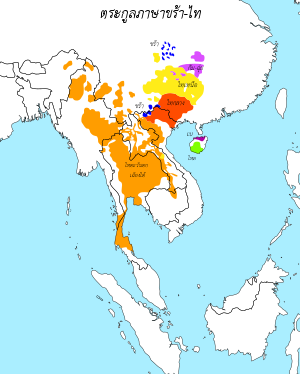ตระกูลภาษาขร้า–ไท (อังกฤษ: Kra–Dai languages) หรือรู้จักกันในนาม ไท–กะได (Tai–Kadai) และ ไดอิก (Daic) เป็นตระกูลภาษาในเอเชียตะวันออกเฉียงใต้ภาคพื้นทวีป จีนตอนใต้ และอินเดียตะวันออกเฉียงเหนือ ภาษาทั้งหมดในตระกูลนี้เป็นภาษาที่มีวรรณยุกต์ เช่น ภาษาไทยและภาษาลาว ซึ่งเป็นภาษาประจำชาติของประเทศไทยและประเทศลาว ตามลำดับ[2] ประชากรประมาณ 93 ล้านคนพูดภาษาตระกูลขร้า–ไท โดยร้อยละ 60 พูดภาษาไทย[3] เอทโนล็อก จัดให้ 95 ภาษาอยู่ในตระกูลนี้ โดย 62 ภาษาอยู่ในสาขาไท[4]
ข้อมูลเบื้องต้น ตระกูลภาษาขร้า–ไท, กลุ่มเชื้อชาติ: ...
| ตระกูลภาษาขร้า–ไท |
|---|
| ไท–กะได, ไดอิก |
| กลุ่มเชื้อชาติ: | Daic people |
|---|
| ภูมิภาค: | ภาคใต้ของจีน, ไหหลำ,
อินโดจีน และภาคตะวันออกเฉียงเหนือของอินเดีย |
|---|
การจําแนก
ทางภาษาศาสตร์: | หนึ่งในตระกูลภาษาที่มีผู้พูดมากที่สุดในโลก |
|---|
| ภาษาดั้งเดิม: | ขร้า–ไทดั้งเดิม |
|---|
| กลุ่มย่อย: |
|
|---|
| กลอตโตลอก: | taik1256[1] |
|---|
 แผนที่แสดงการกระจายของภาษาตระกูลขร้า–ไท
|
ขร้า
กัม-ฉุ่ย
เบ
ไหล |
ไทเหนือ
ไทกลาง
ไทตะวันตกเฉียงใต้
|
|
ปิด
ตระกูลภาษาขร้า–ไทประกอบด้วยกลุ่มภาษาที่จัดแบ่งไว้ 5 สาขา ดังนี้
- กลุ่มภาษาขร้า (อาจเรียกว่า กะได หรือ เก-ยัง)
- กลุ่มภาษากัม-ฉุ่ย (จีนแผ่นดินใหญ่ เรียกว่า ต้ง-ฉุ่ย)
- กลุ่มภาษาไหล (เกาะไหหลำ)
- กลุ่มภาษาไท (จีนตอนใต้และเอเชียตะวันออกเฉียงใต้)
- ภาษาอังเบ (เกาะไหหลำ เรียกว่า ภาษาเบ)
กลุ่มภาษาไหล
- ภาษาเจียมาว (Jiamao) เจียมาว (ไหหลำ)
- ภาษาไหล (Hlai) (ไหหลำ)
กลุ่มภาษาขร้า
- Yerong (จีนแผ่นดินใหญ่)
- ภาษาเก้อหล่าว (Gelao) (เวียดนาม)
- ภาษาลาติ (Lachi หรือ Lati) (เวียดนาม)
- ภาษาลาติขาว (White Lachi) (เวียดนาม)
- ภาษาปู้ยัง (Buyang) (จีนแผ่นดินใหญ่)
- ภาษาจุน (Cun) (ไหหลำ)
- ภาษาเอน (En) (เวียดนาม)
- ภาษากวาเบียว (Qabiao) (เวียดนาม)
- ภาษาลาคัว (Laqua) (เวียดนาม)
- ภาษาลาฮา (Laha) (เวียดนาม)
กลุ่มภาษาไท
- กลุ่มภาษาไทเหนือ
- กลุ่มภาษาไทกลาง
- กลุ่มภาษาไทตะวันตกเฉียงใต้
กลุ่มภาษากัม-ฉุ่ย
- กลุ่มภาษาลักเกีย-เบียว (จีนแผ่นดินใหญ่)
- ภาษาลักเกีย (Lakkia)
- ภาษาเบียว
- ภาษากัม-ฉุ่ย (จีนแผ่นดินใหญ่)
- ภาษาอ้ายจาม (Ai-Cham)
- Cao Miao
- ภาษาต้งเหนือ (Northern Dong)
- ภาษาต้งใต้ (Southern Dong)
- ภาษาคัง (Kang)
- Mak
- ภาษามู่หลาม (Mulam)
- ภาษาเมาหนาน (Maonan)
- ภาษาฉุ่ย (Sui)
- T’en
สาขากัม-ฉุ่ย, เบ และไทมักถูกจัดให้อยู่รวมกันเนื่องจากมีคำศัพท์ที่ใช้ร่วมกันจำนวนมาก (ดูเพิ่มที่กลุ่มภาษากัม-ไท) อย่างไรก็ตามการจัดแบ่งเช่นนี้มีความเห็นที่โต้แย้ง ซึ่งอาจเป็นเพราะมีการแทนที่ศัพท์เข้าไปในสาขาอื่น ความคล้ายกันของระบบหน่วยคำทำให้มีนักภาษาศาสตร์จัดสาขาขร้ากับกัม-ฉุ่ย เป็นกลุ่มขร้า–ไทเหนือทางหนึ่ง และสาขาไหลกับไท เป็นกลุ่มขร้า–ไทใต้อีกทางหนึ่งแทนดังภาพ ตำแหน่งของภาษาอังเบในข้อเสนอดังกล่าวไม่ได้ถูกพิจารณาไปด้วย
ข้อมูลเพิ่มเติม ไทย, ไท ...
| ไทย |
ไท |
เก้อหล่าว |
จ้วงใต้ |
ไหล |
|---|
| หมา |
หมา |
มเปา |
หมา |
ปา |
| ไฟ |
ไฟ |
ไป |
ไฟ |
เฝ่ยฺ |
| หนา |
หนา |
นเต้า |
หนา |
หนา |
| เมฆ |
ฝ้า |
เป๊า |
ฝ้า |
ฝ้า |
| หิมะ |
นาย (ไทใหญ่) |
นไต๊ |
นาย(น้ำค้าง) |
- |
| เหมย (น้ำค้างแข็ง) |
เหมือย (ลาว) |
มไปล้ |
เหมือย |
- |
|
ปิด
Nordhoff, Sebastian; Hammarström, Harald; Forkel, Robert; Haspelmath, Martin, บ.ก. (2013). "Tai–Kadai". Glottolog 2.2. Leipzig: Max Planck Institute for Evolutionary Anthropology. Diller, Anthony, Jerry Edmondson, Yongxian Luo. (2008). The Tai–Kadai Languages. London [etc.]: Routledge. ISBN 978-0-7007-1457-5 "Taikadai". www.languagesgulper.com. สืบค้นเมื่อ 2017-10-15.
- Behr, Wolfgang (2017). "The language of the bronze inscriptions". ใน Shaughnessy, Edward L. (บ.ก.). Kinship: Studies of Recently Discovered Bronze Inscritpions from Ancient China. The Chinese University Press of Hong Kong. pp. 9–32. ISBN 978-9-629-96639-3.
- ——— (2009). "Dialects, diachrony, diglossia or all three? Tomb text glimpses into the language(s) of Chǔ". TTW-3, Zürich, 26.-29.VI.2009, "Genius Loci": 1–48.
- ——— (2006). "Some Chŭ 楚 words in early Chinese literature". EACL-4, Budapest: 1–21.
- ——— (2002). "Stray loanword gleanings from two Ancient Chinese fictional texts". 16e Journées de Linguistique d'Asie Orientale, Centre de Recherches Linguistiques Sur l'Asie Orientale (E.H.E.S.S.), Paris: 1–6.
- Blench, Roger. 2004. Stratification in the peopling of China: how far does the linguistic evidence match genetics and archaeology? Paper for the Symposium "Human migrations in continental East Asia and Taiwan: genetic, linguistic and archaeological evidence". Geneva June 10–13, 2004. Université de Genève.
- Blench, Roger (2017) [2015]. "Origins of Ethnolinguistic Identity in Southeast Asia" (PDF). ใน Habu, Junko; Lape, Peter; Olsen, John (บ.ก.). Handbook of East and Southeast Asian Archaeology. Springer. ISBN 978-1-493-96521-2.
- Brindley, Erica F. (2015). Ancient China and the Yue. Cambridge University Press. ISBN 978-1-107-08478-0.
- Edmondson, J.A. and D.B. Solnit eds. 1997. Comparative Kadai: the Tai branch. Dallas: Summer Institute of Linguistics and the University of Texas at Arlington. ISBN 0-88312-066-6
- Edmondson, Jerold A. (2007). "The power of language over the past: Tai settlement and Tai linguistics in southern China and northern Vietnam" (PDF). Studies in Southeast Asian Languages and Linguistics, Jimmy G. Harris, Somsonge Burusphat and James e. Harris, ed. Bangkok, Thailand: Ek Phim Thai Co. LTD.: 1–25. คลังข้อมูลเก่าเก็บจากแหล่งเดิม (PDF)เมื่อ 2014-01-01. สืบค้นเมื่อ 2021-07-17.
- Holm, David (2014). "A Layer of Old Chinese Readings in the Traditional Zhuang Script". Bulletin of the Museum of Far Eastern Antiquities. 79: 1–45.
- ——— (2013). Mapping the Old Zhuang Character Script: A Vernacular Writing System from Southern China. BRILL. ISBN 978-9-004-22369-1.
- Li, Hui (2001). "Daic Background Vocabulary in Shanghai Maqiao Dialect" (PDF). Proceedings for Conference of Minority Cultures in Hainan and Taiwan, Haikou: Research Society for Chinese National History: 15–26. คลังข้อมูลเก่าเก็บจากแหล่งเดิม (PDF)เมื่อ 2018-03-27. สืบค้นเมื่อ 2021-07-17.
- Ostapirat, Weera (2013). "Austro-Tai revisited" (PDF). Plenary Session 2: Going Beyond History: Reassessing Genetic Grouping in SEA the 23rd Annual Meeting of the Southeast Asian Linguistics Society, May 29–31, 2013, Chulalongkorn University: 1–10.
- Sagart, Laurent (2008). "The expansion of Setaria farmers in East Asia". ใน Sanchez-Mazas, Alicia; Blench, Roger; Ross, Malcolm D.; Peiros, Ilia; Lin, Marie (บ.ก.). Past Human Migrations in East Asia: Matching Archaeology, Linguistics and Genetics (Routledge Studies in the Early History of Asia) 1st Edition. Routledge. pp. 133–157. ISBN 978-0-415-39923-4.
- Zhengzhang, Shangfang (1991). "Decipherment of Yue-Ren-Ge (Song of the Yue boatman)". Cahiers de Linguistique Asie Orientale. 20 (2): 159–168. doi:10.3406/clao.1991.1345.
- Chamberlain, James R. (2016). Kra-Dai and the Proto-History of South China and Vietnam. Journal of the Siam Society, 104, 27-76.
- Diller, A., J. Edmondson, & Yongxian Luo, ed., (2005). The Tai–Kadai languages. London [etc.]: Routledge. ISBN 0-7007-1457-X
- Edmondson, J. A. (1986). Kam tone splits and the variation of breathiness.
- Edmondson, J. A., & Solnit, D. B. (eds.) (1988). Comparative Kadai: linguistic studies beyond Tai. Summer Institute of Linguistics publications in linguistics, no. 86. Arlington, TX: Summer Institute of Linguistics. ISBN 0-88312-066-6
- Mann, Noel, Wendy Smith and Eva Ujlakyova. 2009. Linguistic clusters of Mainland Southeast Asia: an overview of the language families. เก็บถาวร 2019-03-24 ที่ เวย์แบ็กแมชชีน Chiang Mai: Payap University.
- Norquest, Peter (2021). "Classification of (Tai-)Kadai/Kra-Dai languages". The Languages and Linguistics of Mainland Southeast Asia. De Gruyter. pp. 225–246. doi:10.1515/9783110558142-013. ISBN 9783110558142. S2CID 238672319.
- Ostapirat, Weera. (2000). "Proto-Kra." Linguistics of the Tibeto-Burman Area 23 (1): 1-251.
- Somsonge Burusphat, & Sinnott, M. (1998). Kam–Tai oral literatures: collaborative research project between. Salaya Nakhon Pathom, Thailand: Institute of Language and Culture for Rural Development, Mahidol University. ISBN 974-661-450-9
